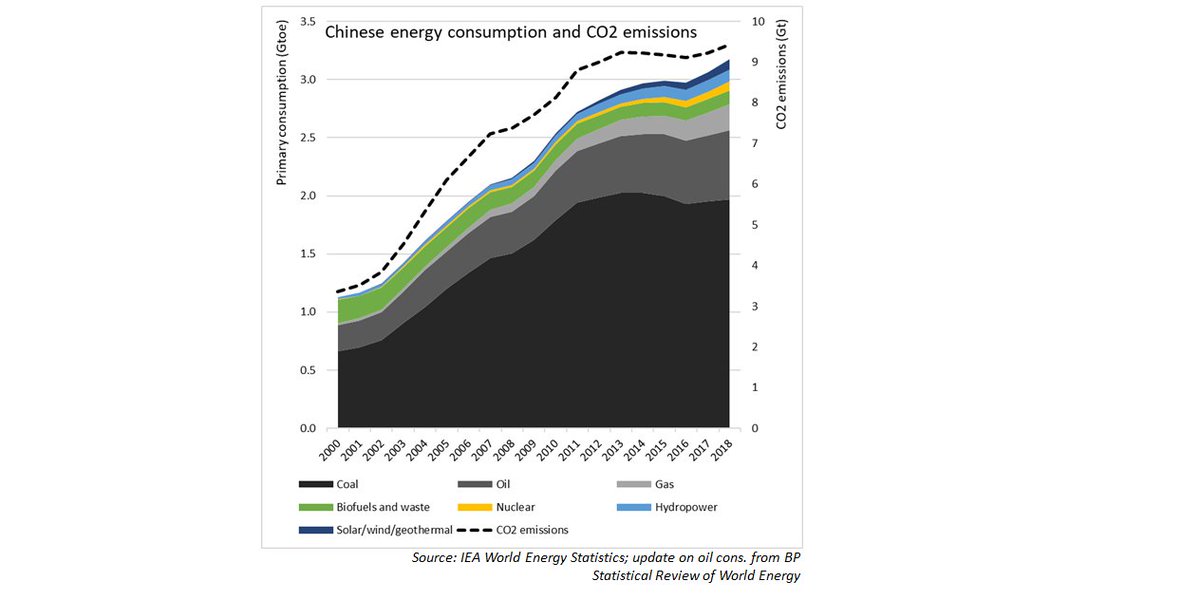China announces it will:
- ratchet up Paris ambitions
- & #39;strive to have CO2 emissions peak before 2030& #39;
- & #39;strive to achieve carbon neutrality before 2060& #39;
Huge news, but what does it mean for now? https://abs.twimg.com/emoji/v2/... draggable="false" alt="👇" title="Rückhand Zeigefinger nach unten" aria-label="Emoji: Rückhand Zeigefinger nach unten"> https://chinaenergyportal.org/en/xi-jinping-announces-china-aims-for-carbon-neutrality-by-2060-at-un-general-assembly/">https://chinaenergyportal.org/en/xi-jin...
https://abs.twimg.com/emoji/v2/... draggable="false" alt="👇" title="Rückhand Zeigefinger nach unten" aria-label="Emoji: Rückhand Zeigefinger nach unten"> https://chinaenergyportal.org/en/xi-jinping-announces-china-aims-for-carbon-neutrality-by-2060-at-un-general-assembly/">https://chinaenergyportal.org/en/xi-jin...
- ratchet up Paris ambitions
- & #39;strive to have CO2 emissions peak before 2030& #39;
- & #39;strive to achieve carbon neutrality before 2060& #39;
Huge news, but what does it mean for now?
The 2030 is not much different. The language until now was to have CO2 emissions peak& #39; around 2030& #39;, now it is to & #39;strive to peak before 2030& #39;.
2060 is far away, but in China long-term targets do often have weight. https://twitter.com/LiShuo_GP/status/1308427133614608384">https://twitter.com/LiShuo_GP...
2060 is far away, but in China long-term targets do often have weight. https://twitter.com/LiShuo_GP/status/1308427133614608384">https://twitter.com/LiShuo_GP...
The big question now is & #39;how& #39;.
One big question is via what trajectory. Existing potential pathways for zero emissions by 2050 have emissions peak by 2025 and substantially reduced by 2030. https://twitter.com/YanQinyq/status/1308513940184403969">https://twitter.com/YanQinyq/...
One big question is via what trajectory. Existing potential pathways for zero emissions by 2050 have emissions peak by 2025 and substantially reduced by 2030. https://twitter.com/YanQinyq/status/1308513940184403969">https://twitter.com/YanQinyq/...
It& #39;s very unlikely that Xi Jinping made the announcement without solid prep work on emissions scenarios by the ERI/NDRC.
But if they know they can aim for zero carbon by 2060, they must have a better idea on the emissions peak than & #39;before 2030& #39;. Why is it not more specific?
But if they know they can aim for zero carbon by 2060, they must have a better idea on the emissions peak than & #39;before 2030& #39;. Why is it not more specific?
Upcoming statements with updated Paris NDC and draft 14FYP will make more clear.
Importantly, will they make a good head start in the 14FYP? Will this plan contain ambitious and more concrete intermediate steps to peaking before 2030?
Importantly, will they make a good head start in the 14FYP? Will this plan contain ambitious and more concrete intermediate steps to peaking before 2030?
What of the coal cap in the 14FYP: will it be raised to 1,300 GW as some have suggested?
Or will the current announcement be followed up by ambitious restrictions on new coal? https://www.carbonbrief.org/analysis-will-china-build-hundreds-of-new-coal-plants-in-the-2020s">https://www.carbonbrief.org/analysis-...
Or will the current announcement be followed up by ambitious restrictions on new coal? https://www.carbonbrief.org/analysis-will-china-build-hundreds-of-new-coal-plants-in-the-2020s">https://www.carbonbrief.org/analysis-...
Will China start to make haste with power market reform and carbon markets?
Both have been in the making for years with only small steps so far.
As state subsidies for wind and PV are ending, something needs to be done to make renewables more profitable versus coal again
Both have been in the making for years with only small steps so far.
As state subsidies for wind and PV are ending, something needs to be done to make renewables more profitable versus coal again
Carbon neutrality should also go beyond electricity.
What will the measures be for transport, steel-making, cement, ammonia/fertilizer, aviation, and other hard-to-abate sectors?
Will 14FYP already see clear plans for these? Or will the 2060 target remain a distant goal?
What will the measures be for transport, steel-making, cement, ammonia/fertilizer, aviation, and other hard-to-abate sectors?
Will 14FYP already see clear plans for these? Or will the 2060 target remain a distant goal?

 Read on Twitter
Read on Twitter


